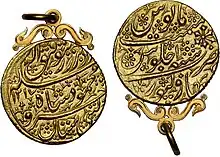| Mahmud Shah Durrani محمود شاه درانی | |||||
|---|---|---|---|---|---|
| Shah of the Durrani Empire | |||||
 | |||||
| Emir of the Durrani Empire | |||||
| 1st reign | 25 July 1801 – 13 July 1803 | ||||
| Predecessor | Zaman Shah Durrani | ||||
| Successor | Shuja Shah Durrani | ||||
| 2nd reign | 3 May 1809 – 1818 | ||||
| Predecessor | Shuja Shah Durrani | ||||
| Successor | Ali Shah Durrani | ||||
| Born | 1769 | ||||
| Died | 18 April 1829 (aged 60) | ||||
| |||||
| Dynasty | Durrani | ||||
| Father | Timur Shah Durrani | ||||
| Mother | a Yusufzai lady | ||||
| Religion | Islam | ||||
Mahmud Shah Durrani (Pashto/Dari: محمود شاہ درانی) ; 1769 – April 18, 1829) was born Prince and later ruler of the Durrani Empire (Afghanistan) between 1801 and 1803, and again between 1809 and 1818.[1] From 1818 to 1829 he was the ruler of Herat. An ethnic Sadduzai tribe section of the Popalzai sub clan of the Durrani Pashtuns, he was the son of Timur Shah Durrani and grandson of Ahmad Shah Durrani.
Reign
Mahmud Shah Durrani was the half-brother of his predecessor, Zaman Shah. On July 25, 1801, Zaman Shah was deposed, and Mahmud Shah ascended to ruler-ship. He then had a chequered career; he was deposed in 1803, restored in 1809, and finally deposed again in 1818.
Trouble with Barakzai tribe
The elder brother of Dost Mohammad Khan, the chief of the Barakzai, Fateh Khan, took an important part in raising Mahmud Shah Durrani to the sovereignty of Afghanistan in 1800 and in restoring him to the throne in 1809. The son of Mahmud Shah Durrani, Shahzada Kamran Durrani, was always in trouble with Amir Fateh Khan Barakzai, the brother of Dost Muhammad Khan. Mahmud Shah repaid Fateh Khan's services by having him assassinated in 1818. After the assassination of Fateh Khan Barakzai, the fall of the Durrani Empires began, incurring the enmity of his tribe. After a bloody conflict, Mahmud Shah was deprived of all his possessions except Herat. The rest of his dominions were divided among Fateh Khan's brothers. King Mahmud Shah Durrani died in 1829. The country was then ruled by Shuja Shah Durrani; another of his half-brothers.
See also
See attached an example of coinage produced in the first reign of Mahmud Shah, a gold Double Mohur, from Bahawalpur, dated AH 1217, year 1, weighing a total of 23.19g with its attached jeweller's mount, lightly gilt, otherwise very rare.
 Photo credits to Sovereign Rarities Ltd., Auction 10, 26th September 2023, Lot 274. See it at this link: https://auctions.sovr.co.uk/index.php?option=com_timed_auction&view=lot_detail&low_estimate=0&high_estimate=55000&keyword=&exclude_keyword=&sort_by=lot_number&image_filter=0&box_filter=0&paper_filter=0&export_issue=0&arr=0&auction_id=20&list_type=list_view&lots_per_page=18&page_no=1&lot_id=755759&search_type=&year=&month=&department_id=&cat_id=
Photo credits to Sovereign Rarities Ltd., Auction 10, 26th September 2023, Lot 274. See it at this link: https://auctions.sovr.co.uk/index.php?option=com_timed_auction&view=lot_detail&low_estimate=0&high_estimate=55000&keyword=&exclude_keyword=&sort_by=lot_number&image_filter=0&box_filter=0&paper_filter=0&export_issue=0&arr=0&auction_id=20&list_type=list_view&lots_per_page=18&page_no=1&lot_id=755759&search_type=&year=&month=&department_id=&cat_id=
See also
References
- ↑ Murtazashvili, Jennifer Brick; Murtazashvili, Ilia (2021-09-09). Land, the State, and War: Property Institutions and Political Order in Afghanistan. Cambridge University Press. p. 40. ISBN 978-1-108-49341-3.
External links